In this Article:
You might ask, “Why write a best-of article about ammo for a less powerful carry gun?” The answer is its popularity. The .380 is more prominent than ever, with a growing number of people carrying it, myself among them. Its popularity has increased significantly in recent years, leading many to consider it a practical self-defense caliber.
We’ll examine:
- PMC Bronze FMJ 90-Grain: uses a 90-grain bullet instead of the more common 95, this ammo rates very highly for its reliability, accuracy, and value at 32.0¢ p/r
- Speer Lawman 95-Grain: is less expensive than the PMC load listed above, it is put together to the highest specs that retail at 29.0¢ p/r.
- Winchester “White Box” .380 95-Grain: is a great value for money although other people are split with ammo being really good or being just ok with an ok price at 29.0¢.
- SIG 90-Grain V-Crown: is reliable in whatever firearm it’s shot in. It is probably not the cheapest out there but it goes bang pretty much every time you want it to, this ammo is a good bargain at 0.85¢ p/r.
- Hornady Critical Defense 90-Grain: is used by many police agencies as a duty round in whatever-caliber-pistol they carry, and thousands of civilian carriers at a reasonable 86.0¢ p/r.
- Federal Hydra-Shok 90-Grain: is known for its great penetration and expansion and it’s a steal at 69.5¢ p/r.
- Winchester PDX-1 Supreme 95-Grain: the most popular self-defense round and what sets this round apart from some others is that it uses a bonded bullet which is pretty good for 87.5¢ p/r.
- Remington Golden Saber 102-Grain: is another favorite by police agencies for duty weapon carry, purchased as the only self-defense round that many people will buy at 52.0¢ p/r.
Feel free to skip to the Our Best 380 Ammo picks section, or read on to see how the .380 ammo has evolved.
The .380’s History
A shot from a .380 was the catalyst, the final straw, that started WWI. Radical Serbian nationalist and anarchist Gavrilo Princip used an FN Model 1910 .380 to assassinate Archduke Franz Ferdinand of the Austria-Hungary Empire and his wife.
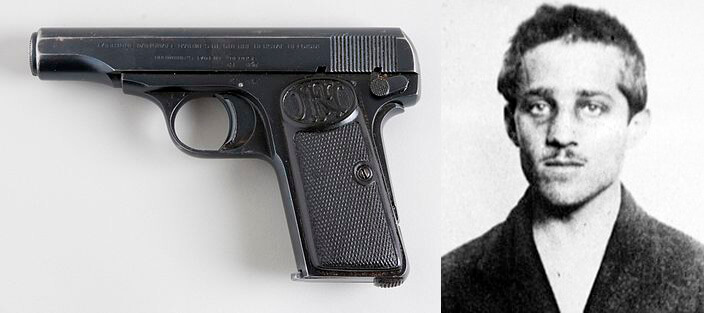
He was a Bosnian Serb affiliated with Young Bosnia, a Yugoslavist organization aimed at ending Austria-Hungary’s rule over Bosnia and Herzegovina. He believed that by assassinating the Archduke, he would trigger the end of Austria-Hungary’s dominance. This event set off a chain reaction of events that ultimately led to the outbreak of the “War To End All Wars” in 1914. (Of course, it did not bring an end to all conflicts.) At the time, the .380 was considered a fairly powerful cartridge, replacing the popular .32 Auto as the preferred carry gun in Europe. However, the advent of the 9mm Luger eventually relegated the .380 to the pocket-pistol category.
Introduced in 1908 by Colt for the Colt Model 1908 pocket hammerless semi-automatic, the .380 ACP has been a favored self-defense cartridge ever since. It is widely used in handguns around the world and is also known as the 9mm Kurz (9mm Short). The .380 ACP shares the same bullet diameter as the 9mm Luger,.355 inches, but is lighter, typically ranging from 95 to 105 grains. It is also referred to as 9X17. Most pistols chambered for this cartridge are of the blow-back design, similar to .22 LR pistols. Generally, it does not produce enough pressure to require a locked-breech action, though some newer .380 models do feature such mechanisms. If you want to know more about guns chambered in .380, read my article about them here.
Today’s Ammo
Fast-forward to todayUthe advent of modern self-defense rounds brings the lowly .380 out of obscurity. With modern defensive ammo, the .380 proves to be a viable self-defense cartridge. Some experts equate its stopping power with that of a 158-grain .38 Special lead round-nose cartridge. It is not as powerful as a 9mm (even out of a short barrel), but with modern ammo, a lot of people carry it as their main CCW gun.
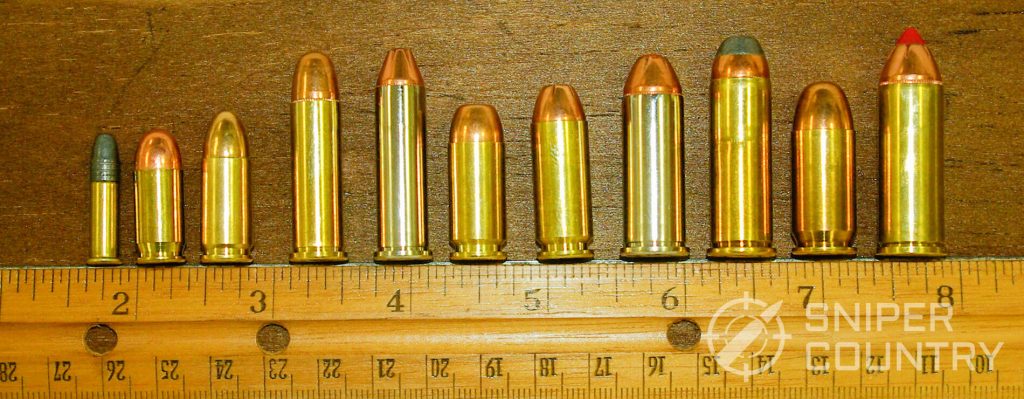
The ammunition scene is very different from what it was even 30 years ago (read my handgun caliber guide here). There are .380 JHP loads that will penetrate a foot or more of ballistic gel, and FMJ rounds that will go pretty far into the gel block.
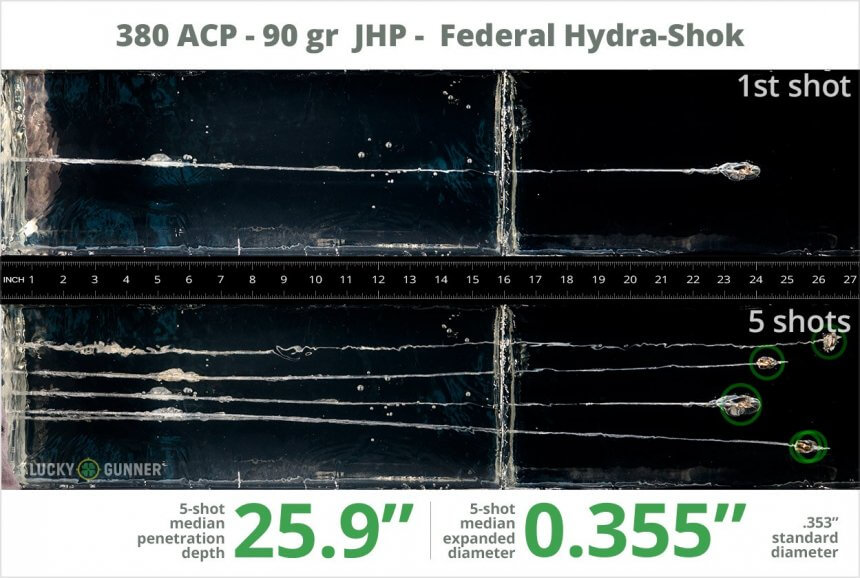
Before the introduction of advanced JHP loads, those carrying a .380 typically opted for 95-grain FMJ ammo. The rationale was that, given the .380’s lower power level and the uncertainty of bullet expansion, an FMJ round would at least offer sufficient penetration to potentially stop an attacker. Some individuals still choose FMJ bullets for their .380 pistols over JHP options, believing that at .380 velocities, reliable expansion is not always achievable.
You might be wondering about JHP and FMJ—what do they mean? Here’s a brief explanation:
A full metal jacket (FMJ) bullet consists of a lead core encased in a copper “jacket” or gilding layer. This jacket may cover the entire bullet or just part of it. The key advantage of FMJ ammunition is its ability to penetrate deeply without deforming significantly upon impact, allowing it to pass through the target. However, if the bullet strikes bone, it may deviate from its path and cause additional damage. FMJ bullets are commonly used in military firearms due to their reliability in feeding and their compliance with international regulations (see below). They typically do not expand and maintain the same diameter throughout their path.
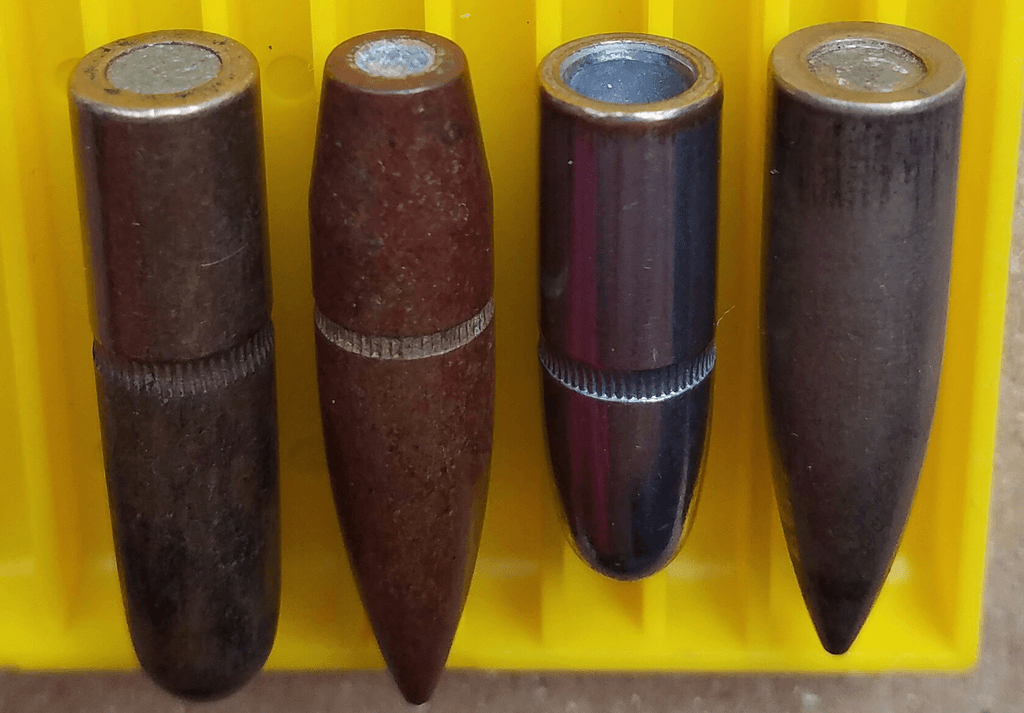
In contrast, jacketed hollow point (JHP) bullets are engineered to expand upon impact. They feature a hollow cavity at the tip, which causes the bullet to expand and deform as it strikes the target. Some JHP designs include scoring or weakening of the jacket to promote reliable expansion. The ideal outcome for a JHP bullet is to expand into a flower-like shape, with the lead “petals” spreading out to increase the bullet’s diameter. This expansion creates a larger wound channel, enhancing the bullet’s potential to incapacitate an attacker.
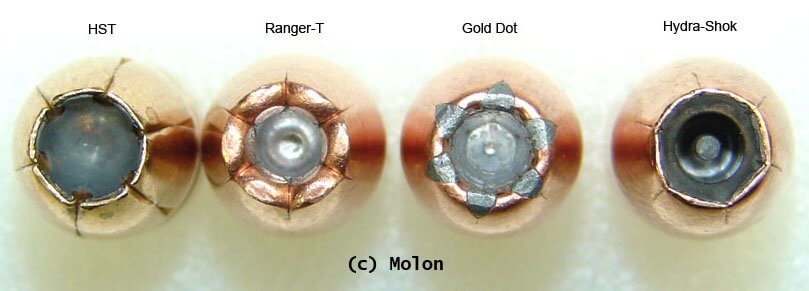
The 1899 Hague Convention’s “Early Warfare Ruling” banned the use of jacketed hollow point (JHP) bullets in warfare, prohibiting their use on the battlefield. While the U.S. did not officially ratify the agreement, it has adhered to these guidelines. However, the U.S. military has been exploring the potential of JHP ammunition, with the Army testing these rounds and considering a shift to JHP bullets for small arms. The rationale is that modern combat scenarios may not follow traditional rules of engagement, so equipping soldiers with more effective ammunition could enhance their safety against hostile targets.
What does this have to do with what you and I carry in our .380 pistols? Not much directly, but it does highlight the increasing use of JHP ammunition in various sectors. Civilians and law enforcement have relied on JHPs for years, and now the Army is exploring their use as well. JHPs tend to offer greater effectiveness, particularly in lower-powered cartridges like the .380. Let’s now examine different types of .380 ammunition.
Our Picks for Best 380 Ammo
I’ll highlight some excellent options for both FMJ and JHP bullets. Many people use .380 FMJ rounds primarily for practice and carry JHP for self-defense. As with any defensive ammunition, it’s wise to test a few different types to determine which ones are reliable and accurate in your firearm.
When practicing, use the less expensive FMJ ammo for most of your session, but finish with a few magazines of your chosen defensive ammo. This way, you’ll become familiar with how it performs. If the JHP ammo impacts the target differently, you’ll be able to adjust your aim accordingly. Additionally, it might have a bit more recoil compared to FMJ, so practicing with it will help you get used to that. Buying ammo in bulk (more than 50 rounds) is often cheaper per round, making JHP ammo more affordable and allowing for more practice.
For reloaders, it’s worth noting that all the ammunition I recommend here uses reloadable brass cases. I intentionally excluded Berdan-primed or steel-cased ammo. While those options are cheaper, I believe you get what you pay for in terms of quality.
FMJ Loads
#1 PMC Bronze FMJ 90-Grain
Although it uses a 90-grain bullet rather than the more common 95-grain, this ammo is highly regarded for its reliability, accuracy, and value. Whether you need 50 or 1,000 rounds, it is available at a reasonable price. PMC (Precision Made Cartridges), based in Houston, Texas, manufactures this ammo to either SAAMI or military standards.
This ammo is generally dependable across various firearms. While it may not be the cheapest option available (steel-cased Russian ammo is less expensive), it offers solid performance as a practice round that reliably fires when needed. For a dependable and affordable choice, this ammo is a great option.
#2 Speer Lawman 95-Grain
Speer has a long history in the ammunition industry, with their Gold Dot JHP load being a popular choice among both police agencies and civilian carriers.
Although it is priced lower than the PMC ammo mentioned earlier, Speer’s Gold Dot JHP is crafted to the highest standards. Speer manages every aspect of its ammunition production in-house, ensuring top-notch quality control. They offer not only excellent loaded cartridges but also a range of reloading components. Over the past 40 years, I’ve invested significantly in Speer products like primers and reloading manuals.
My trusty single-stage press, an old RCBS Jr., has processed thousands of rounds in various calibers, from .38 and .380 to .45 ACP and beyond, and it shows no signs of wear. I mention Speer’s reloading products to highlight their deep commitment to shooting support. If any of their products fail or don’t meet expectations, they stand by their work and will make it right. For affordable yet well-made practice ammo for your .380, Speer is a solid choice.
#3 Winchester “White Box” .380 95-Grain FMJ
Winchester White Box (often referred to as “WWB” on forums) has a mixed reputation, some find it excellent, while others consider it just acceptable. What’s the reason for this? Some forum users criticize it, particularly in 9mm, .40, or .45 calibers, citing reliability issues in certain firearms. However, there are many who speak highly of it, and I count myself among them. I’ve purchased numerous boxes of WWB for various calibers, and I believe it offers great value for the price.
One notable feature of this ammunition is its flat-nosed bullets, rather than the traditional round-nose design. This flat point provides a bit more impact, which is why semi-wadcutters are favored, especially among revolver enthusiasts. From my own experience, they perform well on game animals, and I’d expect the flat-nose .380 version to hit a gallon milk jug with impressive force.
JHP Loads
For practice or general shooting, FMJ ammunition is quite suitable. When at the range, if you encounter a round with a defective primer, you can simply rack the slide and chamber a new one. While this approach works fine for practice, it’s not ideal for self-defense. Defensive ammo needs to meet four key criteria every time:
Reliability is crucial. Your carry gun’s magazine must only contain ammo that consistently performs well in that firearm. Even a few misfires out of a hundred are unacceptable. With so many different brands and types available, there’s no reason to settle for unreliable ammo. Besides misfires, you might also face stovepipe jams or issues with feeding or extraction. Try various loads to determine what functions best in your firearm.
Accuracy is important. While you don’t need pinpoint accuracy at 50 yards, the ammo should be capable of maintaining shots on a B-27 target, which measures 24×45 inches. At distances between 7 and 15 yards, you should be able to place shots in the kill zone. This isn’t the place to discuss training or drills, but ensure your ammo meets at least this standard of accuracy. If your ammo doesn’t align with your gun’s sights, adjust them accordingly. You want your defensive ammo to hit where you aim.
Sufficient penetration is necessary. According to F.B.I. guidelines, duty ammunition should penetrate between 12 and 18 inches in ballistic gel. Penetration of less than 12 inches may not incapacitate an attacker, while more than 18 inches might allow the round to exit the target and potentially harm an innocent bystander. Not all .380 ammunition meets this standard, so you’ll need to test different options. It’s up to you to decide if adhering to the F.B.I. standard is important for your needs.
Sufficient expansion is needed. Not all .380 ammo will expand properly in a soft target. Assess your priorities regarding this. First, determine if you value “flower petal” style expansion from the fired bullet. If expansion is important to you, test various loads to find one that reliably expands. If perfect expansion isn’t a priority, most .380 ammo, including FMJ rounds, should meet your needs. Some people opt for FMJ ammo in their .380s, relying on penetration alone for stopping power, given that many .380 rounds don’t expand effectively at typical velocities. While this was once a common practice, modern bullet technology has improved. Ultimately, the choice is yours.
#1 SIG 90-Grain V-Crown JHP
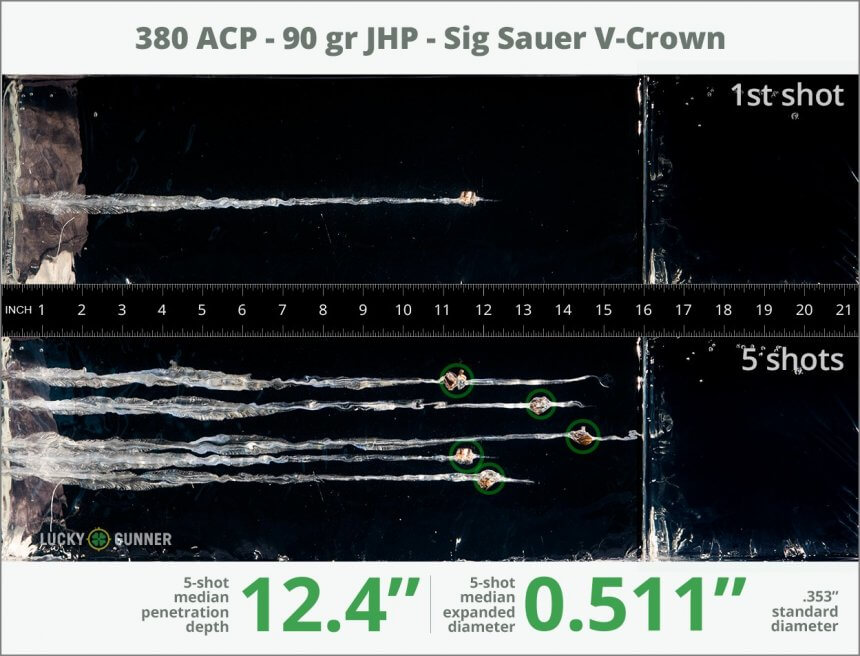
Summary of Ballistic Gel Test Stats: 12.4 inches of penetration, .511 inch expansion
The SIG V-Crown has demonstrated consistent performance over time. The commitment to quality is evident, as they provide ballistic data right on the packaging (below). This ammunition is one of the few that meets the F.B.I.’s 12-inch minimum penetration requirement while also expanding reliably. It should meet the needs of those who depend on both expansion and penetration for their .380 defense ammo.
SIG developed their V-Crown ammunition with short barrels in mind, responding to reliability issues some brands faced with the 9mm P365’s compact barrel. SIG addressed this by creating a round specifically suited for short barrels, which appears to have been effective. The V-Crown series has generally received positive reviews for its performance.
#2 Hornady Critical Defense 90-Grain JHP
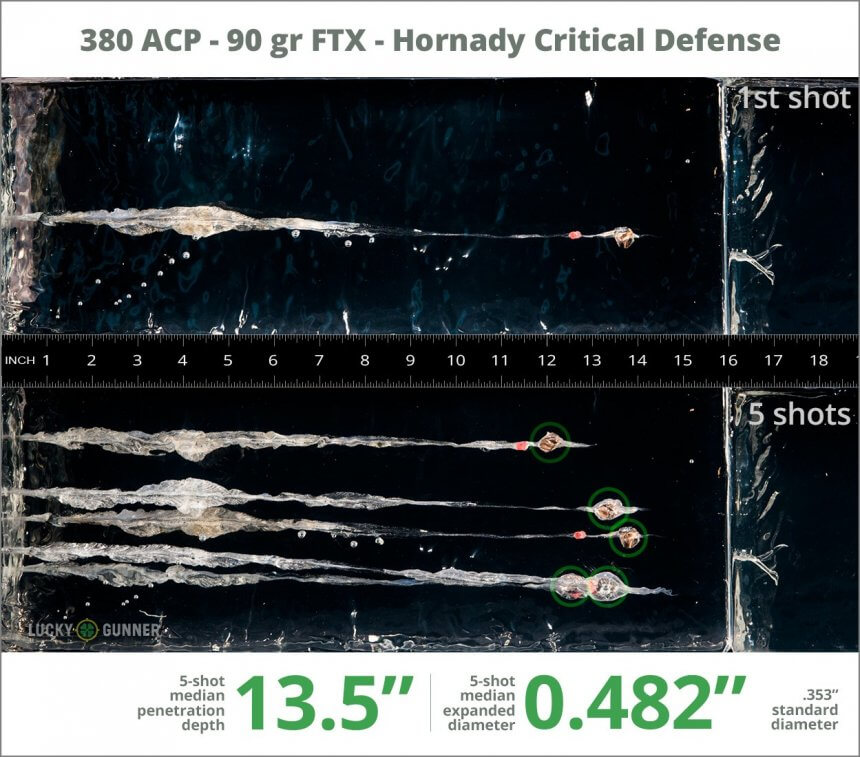
Ballistic gel test for this round Summary of Ballistic Gel Test Stats: 13.5 inches of penetration, .482 inch expansion
Hornady consistently features in “best of” ammo lists, and the FTX bullet is no exception. Its track record of performance, both in laboratory tests and real-world scenarios, speaks for itself. Many law enforcement agencies use it as their duty ammunition across various calibers, and countless civilian users prefer it exclusively.
The Critical Defense brand, in several calibers including revolver rounds, is a top-notch round in terms of reliability and performance. The flex-tip bullet (the “FT” of the “FTX” name) is a soft polymer gel substance that, after striking the target, pushes into the bullet’s nose and then does two things. It helps initiate expansion by literally shoving itself into the soft lead bullet core. It then helps that expansion from being terminated by not allowing debris or other material to plug the hollow point. I have seen many hollow point bullets I’ve shot not expand because they filled with dirt or something else, effectively turning that bullet into a sort-of FMJ solid-nose. The polymer plug prevents that. This is one .380 round that consistently expands. Couple that with the penetration that it achieves and you have a winner.
#3 Federal Hydra-Shok 90-Grain JHP
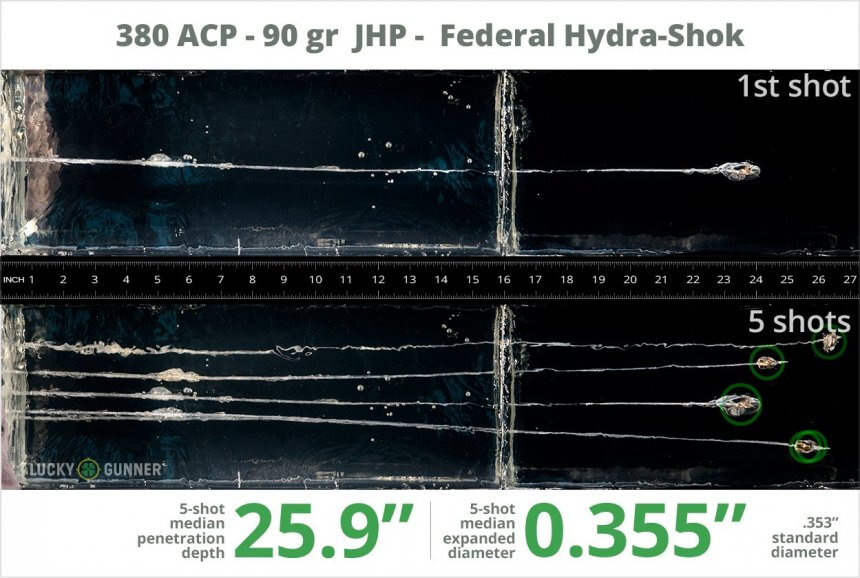
Ballistic gel test for this round Summary of Ballistic Gel Test Stats: 25.9 inches of penetration, .355 inch expansion
When you mention the term “hydra-shok” to any handgunner who’s been around a while, it immediately brings to mind the bullet with the post in the middle…
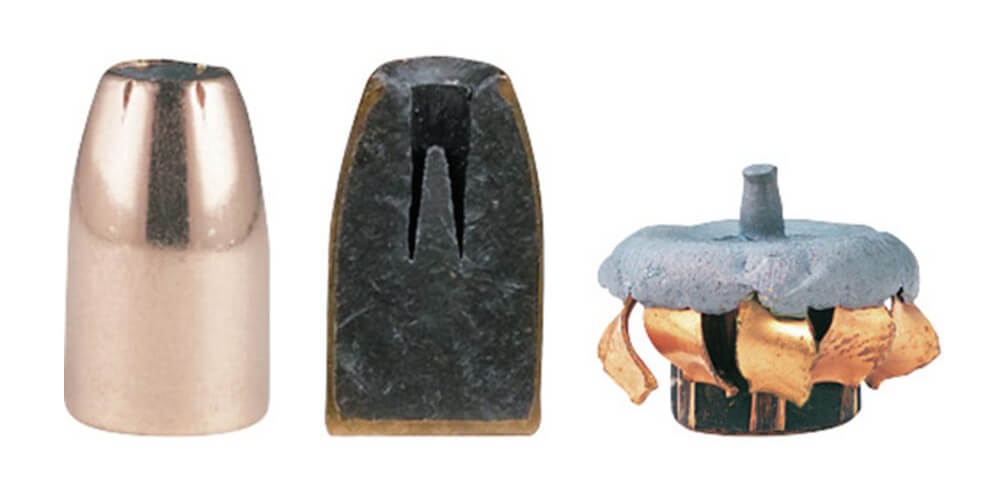
The central post in the Hydra-Shok bullet is designed to control expansion. This round is renowned for its effective penetration and expansion. However, the ballistic gel test results suggest minimal expansion, with the bullet emerging from the barrel at a diameter of only .355 inch. Why did it fail to expand significantly in this test?
Without being present during the testing, it’s difficult to pinpoint the exact reason. Other images of expanded Hydra-Shok bullets show they can expand to nearly twice their original diameter. So why include a round with such limited expansion in a ballistics gel test? There are two main reasons. First, Lucky Gunner’s test results from that day may not reflect the round’s performance on another occasion. Second, some people prefer their .380 ammunition for its penetration capabilities. For example, I’ve occasionally used FMJ bullets in my .380 for their penetration, especially during the colder months in the Midwest when bulky clothing is common.
Here’s a diagram from Lucky Gunner illustrating an unfired Hydra-Shok bullet compared to several fired ones. While the nose did expand, it didn’t achieve the typical “flower-petal” expansion.
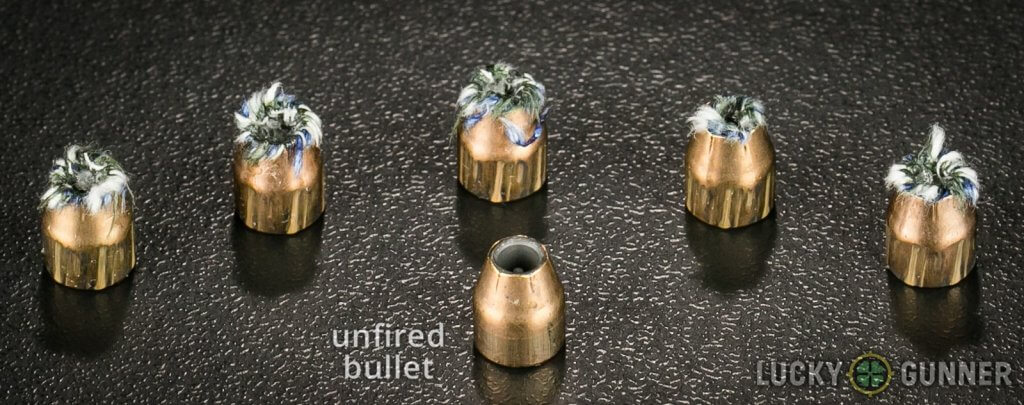
I wouldn’t hesitate to carry this ammunition in my .380. Its penetration is roughly double that of the other rounds discussed, which would make me feel adequately protected. Additionally, consider using this ammo during the winter if you live in a climate with bulky coats, and perhaps switch to another type in the summer if you’re concerned about over-penetration. The advantage of experimenting with different ammunition types is that you can find a few that meet your needs.
Ultimately, it’s important to conduct your own tests with any ammunition you’re considering for carry. You don’t have to use ballistic gel; alternatives like wet newspapers or filled gallon jugs can work as well. Just make sure your results are relevant by comparing ammunition tested in the same medium. Don’t assume that penetration and expansion observed in one type of medium will translate directly to another, like ballistic gel or animal tissue. By comparing similar tests, you’ll get a clearer idea of how different loads perform, helping you choose the best option for your needs. Comparing like-for-like results should assist you in selecting the right ammo to carry.
#4 Winchester PDX-1 Supreme 95-Grain JHP
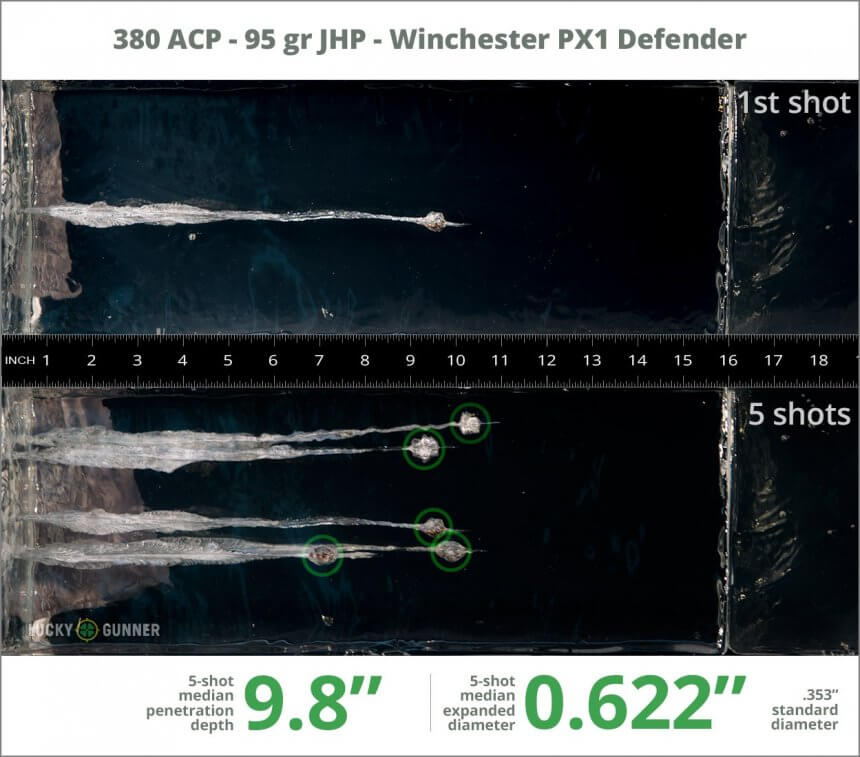
Let’s examine one of the most popular self-defense rounds available. The PDX-1 is used by various police agencies in different calibers and has a solid reputation in the field. Comparing the stats, you’ll notice that the PDX-1’s performance contrasts sharply with that of the Hydra-Shok. The PDX-1 has 9.8 inches of penetration, significantly less than the nearly 26 inches achieved by the Federal round, but its expansion is .622 inches, which is much larger than the Hydra-Shok’s .355 inches—representing a 57% increase.
If you’re seeking a bullet that expands aggressively, the PDX-1 might be your top choice for testing. It has consistently received positive reviews and is known for its low-flash performance. I tested it at dusk, and the flash was minimal, notably less than some other rounds discussed. Since many defensive encounters happen in low-light conditions, reducing muzzle flash can help avoid impairing your vision when preparing for a follow-up shot.
What distinguishes this round from others is its bonded bullet design. The manufacturer employs a proprietary technique to bond the bullet’s jacket to the lead core, preventing separation upon impact. This bonding helps maintain the bullet’s weight, leading to more effective penetration and expansion. The PDX-1 has been a trusted duty load for the F.B.I. in 9mm for some time, and if the technology is reliable for them, it’s reasonable to expect that the .380 version would be a strong choice for civilian use.
#5 Remington Golden Saber 102-Grain JHP
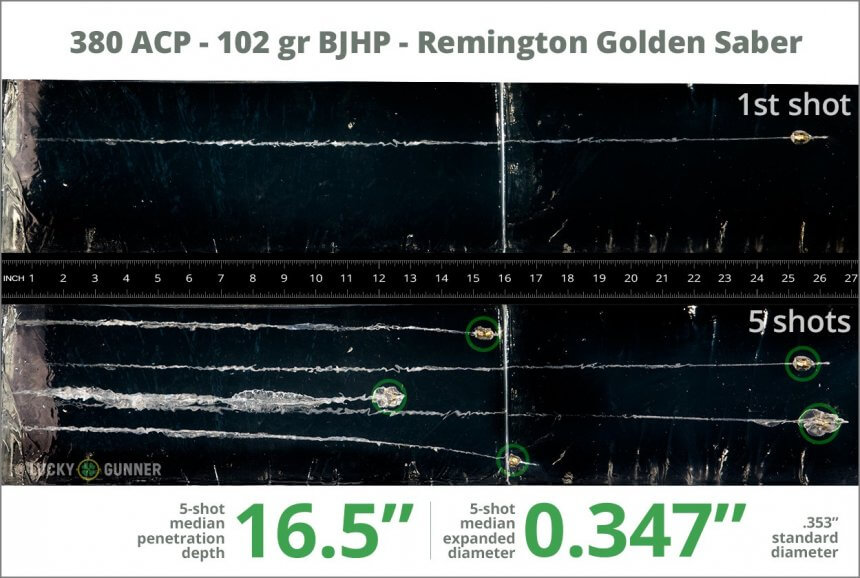
Summary of Ballistic Gel Test Stats: 16.5 inches of penetration, .347 inch expansion
The Golden Saber is a well-regarded ammunition choice with a long history. It’s favored by police agencies for duty carry and is often the sole self-defense round chosen by many individuals. This ammunition performs reliably in a variety of firearms, making it a popular choice for those with multiple .380s in their collection. Its strong track record speaks to its effectiveness.
What distinguishes the Golden Saber from other JHP loads is its use of a 102-grain bullet. While this isn’t a drastic increase from the more common 95-grain bullets, every bit of added mass contributes to performance. For comparison, a 95-grain bullet traveling at 985 fps generates approximately 205 ft./lbs. of energy, while the 102-grain bullet provides an additional 15 ft./lbs. As noted, in a lower-powered round like the .380, every little bit of energy can make a difference.
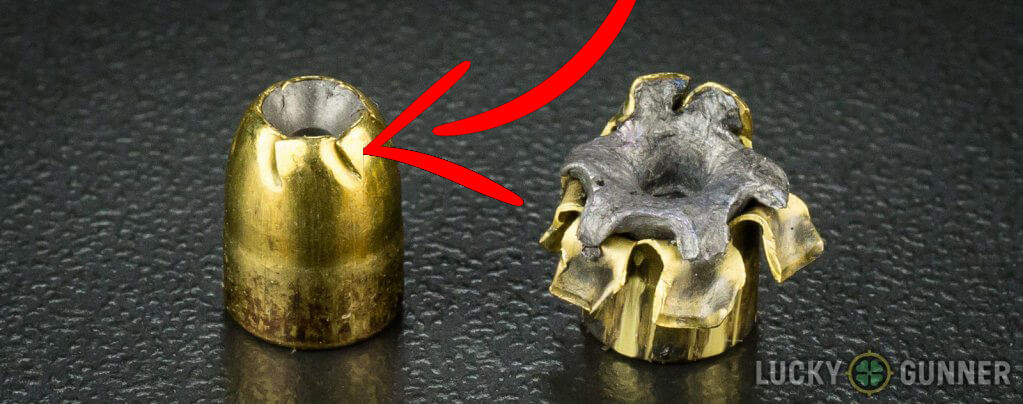
Observe the angled score marks on the jacket, which are designed to facilitate initial expansion.
The Golden Saber .380 is a solid option for a carry load. With decades of experience in ammunition production, Remington has refined their processes to ensure high-quality performance. Coupled with its use by professionals in various calibers, the Golden Saber provides a reliable choice for your carry needs.
Special Offer: Join our private community and get exclusive gun deals, handpicked gear recommendations and updates on law changes, every day!
Join our private community
Honorable Mention
There are countless excellent .380 loads available, and this article could easily continue indefinitely. However, I’ll wrap it up by highlighting a few additional noteworthy options for you to explore. Keep in mind the key attributes of a good load: reliability, accuracy, expansion, and penetration. If I had to prioritize just one of these factors, I would choose reliability. While gel tests are valuable, a cartridge that expands significantly and penetrates deeply is of little use if it doesn’t function properly in your firearm.
With that in mind, here are a few more options for your consideration:
What Now?
Let’s say you’ve just brought home a new .380 and are deciding what ammunition to use. To start, I recommend using a couple of FMJ loads to both break in the gun and familiarize yourself with it. Ensure that the firearm reliably cycles whatever ammunition you use before you begin selecting carry ammo. Purchase two or three different boxes of JHP ammunition if that’s your preference for self-defense (though some opt for FMJ, which is also an option).
Once you identify one or two loads that perform reliably in your firearm, focus on one brand and practice with it extensively. This will help you get comfortable with its recoil, point of impact, and other handling characteristics.
Practice, Practice…
At the range, use your practice ammunition for the majority of the session, but be sure to finish with your self-defense ammo. You don’t need to fire 50 rounds of defensive ammo each time; a magazine or two should be sufficient if you shoot regularly. Practicing once a month won’t establish good habits—aim for weekly sessions, or even more often if possible. While it’s easier for me to suggest frequent shooting with my range conveniently located, make an effort to practice as often as you can.
Additionally, don’t limit yourself to bullseye shooting. There are numerous defensive shooting drills available online, particularly on YouTube, that can enhance your skills when practiced regularly. As for taking a class, that’s a personal decision. It could be beneficial if you find the right course (though that’s a topic for another article).
The .380, aside from helping to start WWI, is nowadays a very popular and viable self-defense weapon. Many of us carry a .380 when we go out because it’s easy. I can slip my Taurus Spectrum in its pocket holster and be on my way without fiddling with belt holsters (Best Concealed Carry Holsters). If you have one (or are thinking about one), hopefully this article gives you a place to start in your quest to feed it. Please leave a comment below about your experience with .380 ammo.

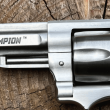



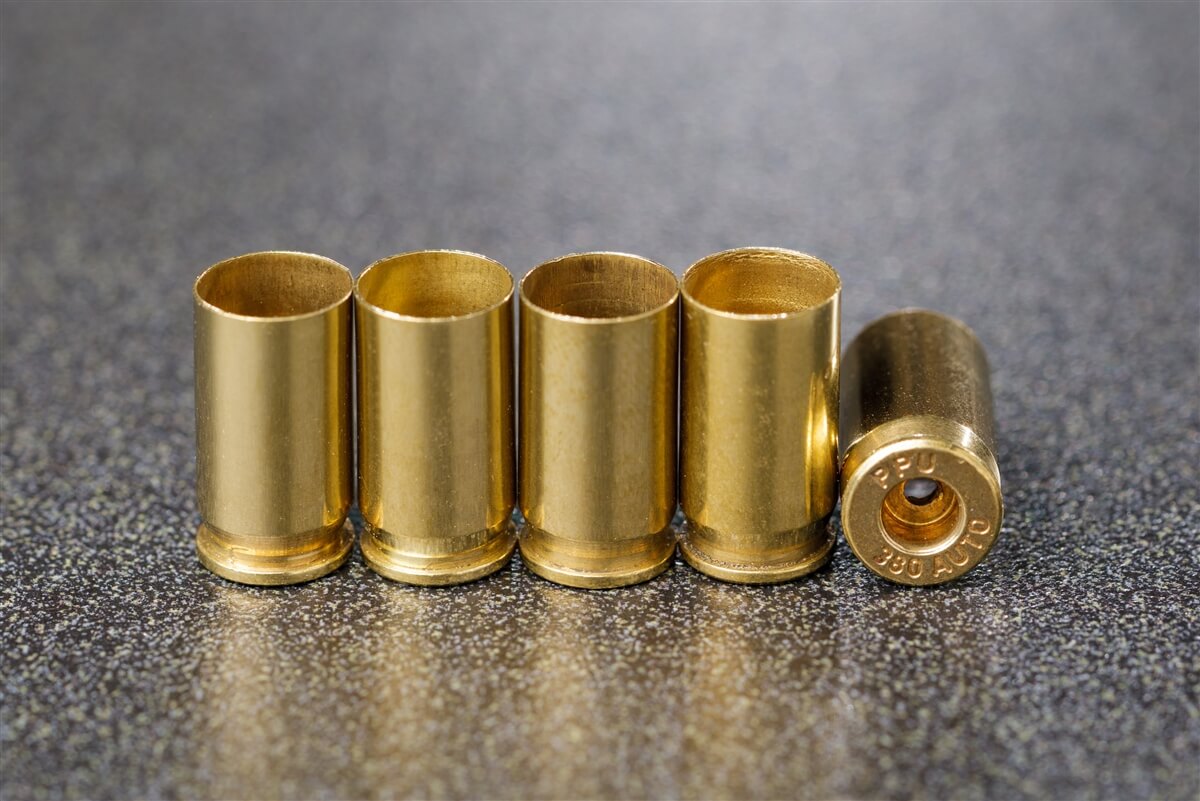
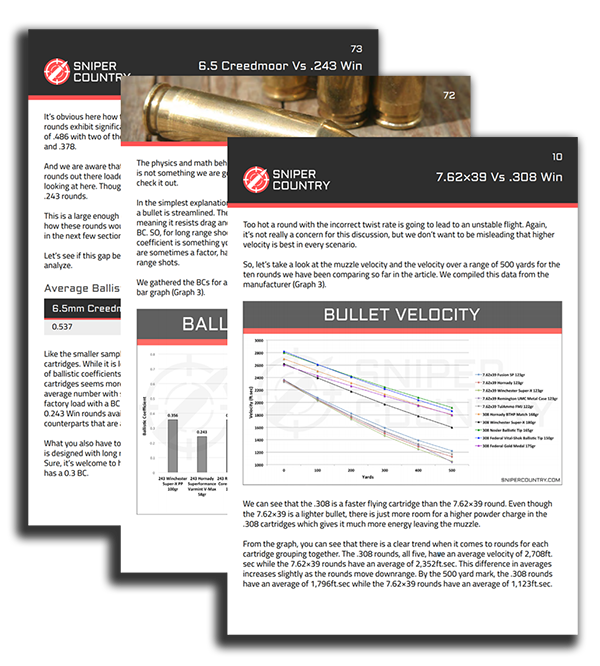


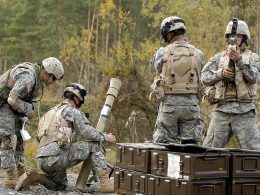
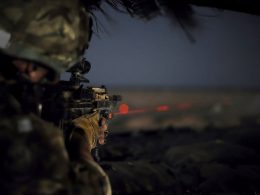
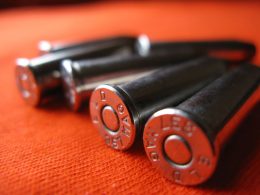
![4 Best 3Gun Scopes [2018]](https://www.snipercountry.com/wp-content/uploads/2018/06/4-Best-3Gun-Scopes-2018-260x195.jpg)
The last two boxes of Winchester white box I bought, in two different calibers, neither of them.380, admittedly, were absolutely filthy, dirtiest ammo I’ve ever shot. That was during the great ammo shortage, when some manufacturing standards seem to have slipped, so maybe it’s better now.
Steve, I’ve not noticed that about the WWB stuff, but each lot of ammo could vary a bit. During the shortage, companies were working flat-out to get ammo to dealers, so QC might have slipped a bit – don’t know. Anyway, I’ve had good luck with the .380 and the 9mm. Thanks for your comment!
I too am a fan of the .380 boight on for the so she would go to the range with me and I fell in love with it my self we got the S&W 380 ez great weapon and I do invite anyone who does not believe they are powerful enough to use for self protection to come on over and I will be glad to put a round in their foot just to help them see the light.lol. But all kidding aside the round is surprisingly powerful and a lot of fun to shoot
I just wish enough people would shoot them to get the price for ammo down
Thanks for the most informative article
William, Thanks for the kind words. I agree – demand creates supply, and a big supply usually leads to lower prices (I didn’t pay attention too closely in Econ class – I was a music major!). Anyway, the .380 IS a different round than it was even 20 years ago. I, for one, would not volunteer to be the guinea pig on the receiving end of one. As for the EZ380, S&W recently came out with three tricked-out Performance Center versions of that gun (https://www.smith-wesson.com/firearms/performance-center-mp-380-shield-ez-m20-black-ported-barrel). You can even get a gold-plated barrel, if that’s your thing. The two things I immediately noticed about the EZ380 when I first picked one up were how incredibly easy the slide is to rack and that the grip safety is “upside-down”. That makes, sense, too – it’s hinged at the bottom. Great gun. Thanks for your comments!
Underwood and doubletap make excellant self defense rounds. Not just in 380. Their 357 and 10mm rounds are awesome. And they have a light load very fast 380. 9mm rounds in+p and +p+ shoot great in my glock 19 and sig fullsize.
Douglas, they both make great stuff. I think that they’re just not as well known as some of the bigger players, plus not a small shops carry a full line of their stuff. They make great ammo, to be sure-very effective in whatever caliber you buy. Thanks for the comment!
Great article! Thank you so much, I learned a lot. I have 2 .380s, a Ruger LC380 and a Bersa Thunder, the first 2 handguns I bought. Love them both, but moved up to the LC9 and a Glock 19 for CC, based on the power factor and less cost. Made sense to me. The LC380 does have a problem with some loads – it has a tough time stripping the final round in the mag into the chamber and stove pipes. Due to this, I’m not at ease carrying this one, and the Bersa is a tad bulkier, so the LC9 is my main carry gun. Don’t love the long notchy trigger but I am used to it. Based on your article, I will try a few more loads in the LC380 to see if I can find one that works well.
Again, great article, THANK YOU! Brian
Brian, Thanks for the kind words. I own and carry a 380 so I have a dog in this fight. The LC380 is a great gun, but was discontinued when Ruger figured out they could put the 9mm round in the same size gun, so lots of guys quit buying the LC380 in favor of the LC9(s). It’s a great gun though – just keep experimenting and you’ll find something that works. As for your LC9 – is it that one or the LC9S? The hammer-fired one does have trigger issues, but my LC9S has one of the best striker-fired-gun triggers I’ve ever used. You may want to think about swapping it for the S version. Anyway, great comment-thanks!
A great 380 round is the Lehigh Defense by them and Underwood ..better penetration and great wound channels without over penetration. I carry these in the Ruger LCP 2 in the summer. The rest oftheyear it’s Sig Sauer P365 with CorBon DPX or SuperVel
James, you are right about the Lehigh and Underwood rounds. I just had to draw the line somewhere. The defense rounds now being made by who I call the major players (Speer, Hornady, Remington, etc.) are so much better than they used to be and tend to cost a little bit less than the Lehigh, Underwood and Doubletap rounds so I mostly mentioned the mainstream rounds. The other specialty rounds are great. That’s the hard part about writing this type of article – you do have to cut it off at some point. Thanks for your comment!
I routinely carry a .380 this time of year. T shirt and shorts, and my .380. Easy consealability, light weight,stopping power (in my opinion). When I practice, admittedly not often enough,I use FMJ and finish with my carry load,FTX 90 gr. I did exactly what Mike suggested and tried several different types and manufacturers,including several mentioned in this article. For me,the FTX had zero jams,misfires and was consistently on point of aim. Several of the others tended to shoot low to point of aim. Having several .380’s in my safe,I normally carry the Glock 42, which was the pistol used to determine this article’s response.
Thanks Mike! Keep on writing.
Dave, I appreciate your comments and thank you for your kind words. You are a great example of what happens when you experiment with different loads in order to find the best one for your gun. Glad the FTX works so well for you – it’s one of the best JHP loads. Even if you’re a shooter who carries FMJ rounds for self defense, you should experiment with different types – you’ll find one that shoots close to point of aim, is reliable and functions the gun. Experimenting with different loads works for any type or caliber of ammo. Thanks again, Dave!
I have An MP Bodyguard with the laser built in. I discovered it likes
AE, WWB, Lawman, .and Blazer brass to name a few fmj loads. These never require a second strike. I was reading someplace (always a good source) that the XTP bullet does quite well in whichever company loads it. I have a few mags worth in the Hornadyle lineup. They also mentioned the Hydrashock faring pretty decent in the 2.75″ barrel. I tend to load 5 WWB with either a XTP or Hydrashock on top of them and another JHP in the chamber. I’ve ran a couple dozen setups like this and they’ve always been a success in my BG. I have a gen 4 Glock 19 which is the main pistol out here but will consider the Bodyguard when its good and hot during the summer when its T-shirt and shorts weather in summer.
Maricica, sounds like you’ve got it figured out. The new 380 loads are great, much better than before. Thanks for writing!
Thanks for the article. Price per round vs. 9mm is unacceptable. I’ll be getting the Taurus G2C in 9mm, TYVM. A gun that small with a superior round =’s no comparison, IMHO.
Dave, the G2C is a great choice…have fun with it!
There is no “best” anything ammo or whatever when it comes to firearms.
I have had Speer GD FTE in a new S&W Bodyguard for instance. Springs were too new and strong. And not enough power in the Speer to overcome that until it was broken in.
One you overlook that is very good in 380 is Fiocchi Extreme (not regular but extreme, and a little hard to find). Excellent ballistics and reasonable price.
BgDnTx, you are right. I just have to draw the line somewhere. Not all guns will shoot all loads equally well. You just have to experiment, and what works for you may not work for someone else. At least we have a decent selection in .380 ammo now. Appreciate the comment!
Mike, in your experienced opinion with reloading and understanding of boolets… After looking at bullets and their design offered by different manufactures I noticed that some JHP’s have relief marks on the nose of the bullet to aide in proper expansion. Instead of that, what if manufacturers added a “swirl” style to it?
Would that help increase bullet velocity at all?
Dominic, I doubt if any “cuts” on the jacket would increase velocity – that would be more a function of bullet weight and powder charge. I’m sure that they’ve looked at all types of variations of bullet jacket scoring and other factors, including jacket thickness. Could be an idea, though. Thanks for writing!
Mike:
I would appreciate your advice on best choice of .380 ammo for a Colt model 1908 ACP hammerless pocket pistol? I recently inherited a nickel-plated 1936 pistol in excellent condition. I am reluctant to use modern high performance rounds in this gun. What ammo design and grain size are considered safe for older models like this? Is it even wise to fire them regularly?
John, wow…not sure I’m qualified to make that call. If it was a recently-made gun, I could recommend just about any standard-pressure ammo out there, but with it being an older example, I think I’d take it to a gunsmith if I were you and get his opinion. I agree with you that I’d be careful about shooting new, higher-pressure ammo in it. Even though the .380 works at lower pressures, you don’t know what condition the gun’s steel, springs, etc. are in so I’d be careful.I handload the .380, and my loads are target-velocity-range, but even so, I’d want clearance to shoot even that. Without seeing the gun or knowing anything about it, I believe I’d defer to him. Better to be safe than sorry! Thanks for writing – I truly appreciate your asking me about it – I just don’t feel qualified to make this call. Thanks again for writing!
Thanks very much for your reply, Mike! I do intend to take the .380 M1908 ACP to a qualified armorer for spring replacement and ammo advice. Regards, John.
Sounds like a good plan, John…keep us posted!
Very informative for a newbie. Thanks for the eduction and for giving me several
Options.
Tracie, glad to help! Thanks for writing.
Tracie, glad to help. Thanks for writing!